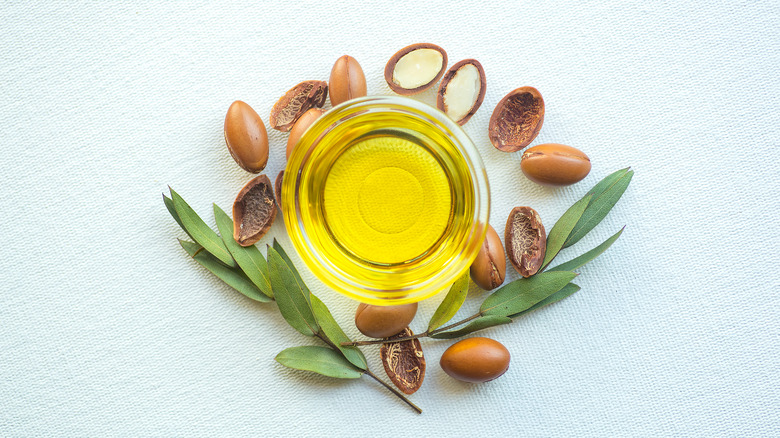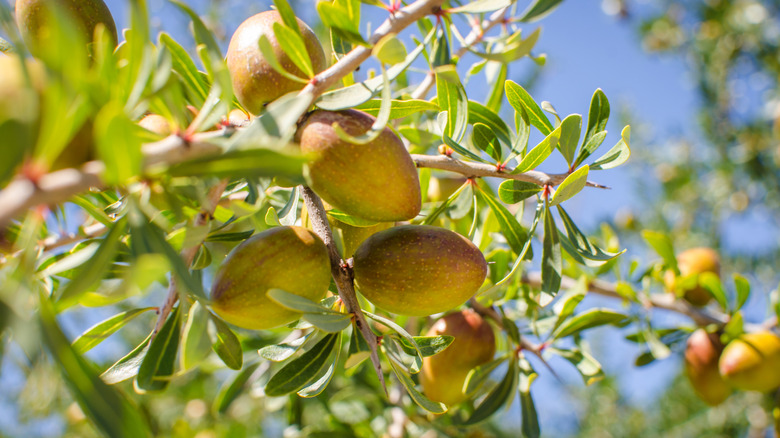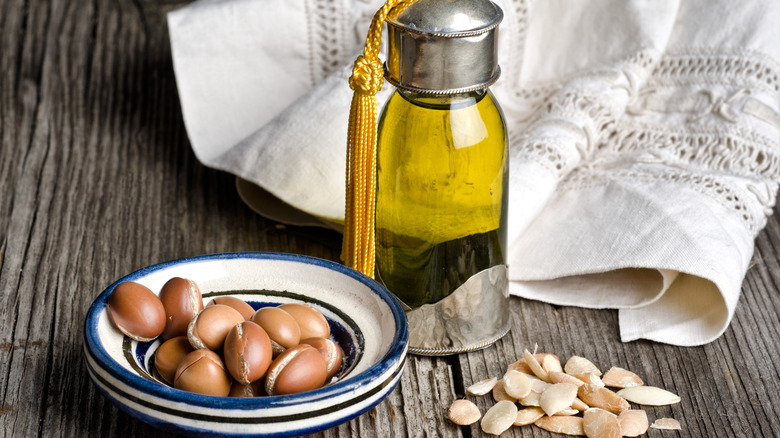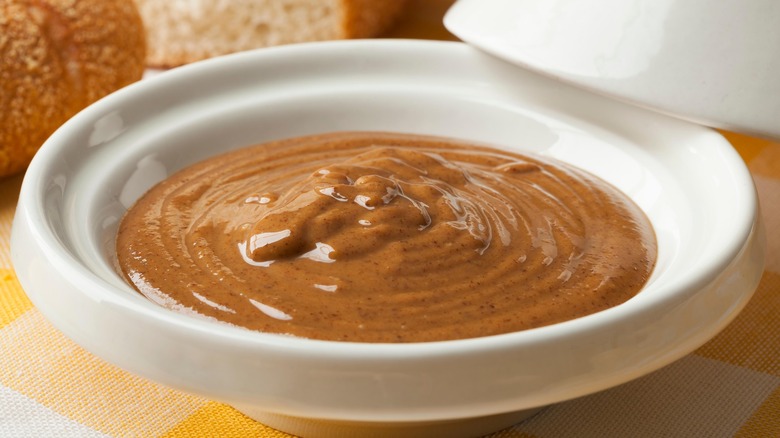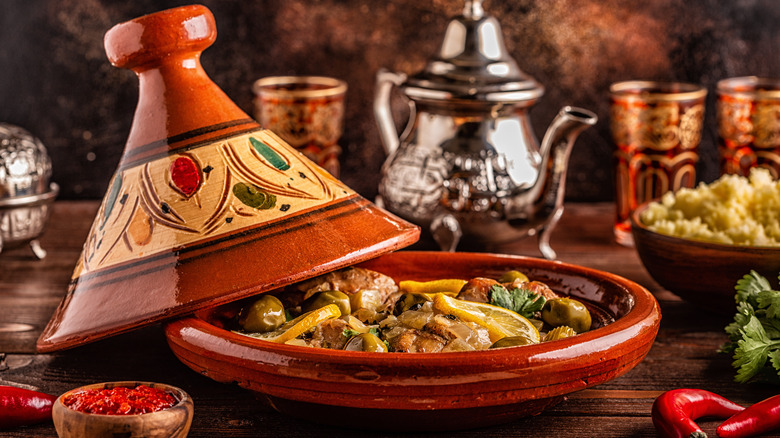Argan Oil Is A Uniquely Expensive Ingredient In Moroccan Cuisine
You've undoubtedly come across an argan oil beauty product at this point. It's popping up in everything from hair and skincare to makeup. It's long been a staple in Moroccan cuisine, however, and is worthy of trying a drizzle over just about everything. The rare, expensive bottle of liquid gold does everything from make your hair shiny to a better-tasting breakfast spread. Hence why it's sometimes referred to as "Moroccan miracle oil."
The difference between the bottle of argan oil you whip up a meal with and the one you use to slather all over your skin and hair is in the production. The seeds used to make cosmetic-grade argan oil are not toasted. This results in a lighter-colored liquid sans the nutty taste. You wouldn't want to eat it and it goes both ways — slathering the cooking version on your face would be as equally unpleasant.
The culinary grade argan oil is a flavorful, delicate ingredient with a distinct flavor and an arsenal of health benefits. That laborious and time-consuming process of how it is made is responsible for the how price point. Once you try it, however, you may just find it worth it.
What is argan oil?
Argan oil is extracted from the seeds of the argan tree, known as Argania spinosa. The trees only grow along a small strip of Morocco's coast. The argan fruit is slightly larger than an olive and shaped and colored similarly. The fruit itself is extremely bitter tasting and unappealing to humans, though animals enjoy it.
The seeds are almond-shaped and one fruit may contain up to three of them. When the fruit falls from the tree in the summer, it dries up, shrivels, and browns, and is then ready for the seeds to be extracted. In order to get to the seeds, a hard nut shell and the flesh of the fruit need to be removed first. This is a labor-intensive practice requiring force to break through the hard exterior, but a delicate touch to ensure the seed and its oil is not damaged. The extraction process is typically done by hand, even with commercial production, hence the expensive price tag. The oil is then extracted via a stone mill or commercial cold press.
Goats are known to climb argan trees to get to the fruit. They are unable to digest the seeds so back in the day they were collected from the goats' excrement. Nowadays, the process has been streamlined and sanitized and no goats are involved, thankfully.
What does argan oil taste like?
Argan oil has a nutty hint to it and is akin to other nut oils such as walnut or hazelnut. Its texture is silky and smooth and its taste is subtle and won't overpower a dish. The seeds are roasted prior to pressing the oil, which gives the oil a deep golden hue. The oil also has a nutty aroma and the scent of the roasting nuts prior to extraction has been likened to movie theater popcorn, though their taste not so much. The nuts are too astringent for human consumption, but the leftover solids after pressing are used as animal feed and the hard exterior shells are used as firewood.
Just like a nut can be enjoyed either salted or candied, argan oil is versatile in its culinary uses and can star in a decadent dessert or shine in a savory entrée with ease.
How to cook with argan oil
The culinary applications of argan oil extend well beyond just Moroccan cuisine. It can be enjoyed raw, such as drizzled over cous cous, a salad, or vegetables, and is occasionally used as a cooking oil. Argan oil has a low smoke point, meaning it shouldn't be heated above medium-low heat in order to preserve its nutrients and avoid breaking down and affecting its flavor and causing free radicals. This is precisely the reason the extraction process is cold-pressed.
It is best enjoyed as a finishing oil and at room temperature to enhance its nutty flavor tones. Much like olive oil, it makes a delicious dip for bread, and mixed with lemon results in a rich salad dressing. It is often mixed with honey and nut butter to make amlou, a Moroccoan breakfast staple spread. It works as a marinade for meats and vegetables that will be slow-roasted at a lower temperature, such as tagine, or grilled over indirect heat. Argan oil also lends a subtle roastiness to baked goods like cakes, cookies, and brownies. A drizzle over ice cream or yogurt also offers a rich and nutty spin.
Nutritional information of argan oil
The health benefits of argan oil are extensive. It is a rich source of essential fatty acids, particulaly linoleic acid, or Omega-6, and oleic acid, or Omega-9. It is also an abundant source of vitamin E which is an effective antioxidant and helps boost the immune system. It also contains phenolic compounds which are known to be anti-inflammatory and fight free radicals, according to Healthline.
Research suggests argan oil may help lower levels of LDL cholesterol and triglyceride levels, and may be similar to olive oil in its heart-healthy antioxidant capacity. There is also evidence it may help lower blood sugar levels and prevent insulin resistance, warding off potential type 2 diabetes. There is also some evidence it may slow the growth of cancer cells including prostate, breast, and colon.
One tablespoon of argan oil has 8 grams of fat and 72 calories, per WebMD, and just trace amounts of protein and carbohydrates.
Where to find argan oil
While argan oil products may line the personal care and hair aisles of drug stores, beauty outlets, and departments stores, finding its cooking counterpart may not be as straightforward. Health food markets and speciality stores will most likely carry the culinary version in their cooking oil sections. It is also readily available online. Be sure to peruse the label to ensure it's for your food, not you face, and is authentic argan oil from Morocco. Also check the ingredient list and look for 100 percent pure argan oil — and that's it, the only ingredient. A bottle of argan oil is pricey and you want to ensure you're getting the real deal.
As argan oil is composed of polyunsaturated fats, Omega-6s and Omega-9s per Healthline, the real deal will come in a dark, glass bottle to protect it from light and heat exposure that degrade it. You want to do the same when you store the bottle at home and keep it in a dark place far away from your oven or any source of high temperatures.
